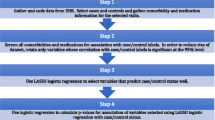Abstract
In the refinement of healthcare practices, interrelated visitation and excessive medications rates are vital. This article extracts pertinent data evidence in a novel manner using a new bivariate probability model and probes their balancing nature. For this purpose, we introduce a parameter, \(0 < \xi < 1\) and investigate its role. All expressions in our new methodology are explained with big healthcare data. Some comments are made for future work to refine more healthcare practices.





Similar content being viewed by others
References
Cameron, A. C. P., Trivedi, F. M., & Piggot, I. (1988). A micro econometric model of the demand of health care and health insurance in Australia. Review of Economic Studies, 55, 85–106.
Ding, D., Pan, Q., Shan, L., Liu, C., Gao, L., Hao, Y., et al. (2016). Prescribing patterns in outpatient clinics of township hospitals in China: A comparative study before and after the 2009 Health System Reform. International Journal of Environmental Research and Public Health, 13, 679.
He, A. J. (2014). The physician patient relationship, defensive medicine and excessive medication in Chinese public hospitals: Evidence from a cross-sectional survey in Shenzhen city. Social Science and Medicine, 123, 64–71.
Li, Y., Xu, J., Wang, F., Wang, B., Liu, L., Hou, W., et al. (2012). Over prescribing in China, driven by financial incentives, results in very high use of antibiotics, injections, and corticosteroids. Health Affairs, 31(5), 1075–1082.
Parveen, Z., Gupta, S., Kumar, D., & Hussain, S. (2016). Drug utilization pattern using WHO prescribing, patient care and health facility indicators in a primary and secondary health care facility. National Journal of Physiology, Pharmacy and Pharmacology., 6, 182–186.
Sacarny, A., Yokum, D., Finkelstein, A., & Agrawal, S. (2016). Medicare letters to curb over prescribing of controlled substances had no detectable effect on providers. Health Affairs, 35(3), 471–479.
Shanmugam, R., & Chattamvelli, R. (2015). Statistics for scientists and engineers. Hoboken: Wiley. ISBN 978-1-118-228968.
Acknowledgements
The author appreciates the editor and referees for their help to revise the manuscript. The author thanks Texas State University for a travel support to present this research work in the 5th EAI Conference on March 8–9, 2018, Chennai.
Author information
Authors and Affiliations
Corresponding author
Additional information
Publisher's Note
Springer Nature remains neutral with regard to jurisdictional claims in published maps and institutional affiliations.
Rights and permissions
About this article
Cite this article
Shanmugam, R. Parity between prescription and visitation rates in healthcare. Wireless Netw 27, 5511–5518 (2021). https://doi.org/10.1007/s11276-019-02204-2
Published:
Issue Date:
DOI: https://doi.org/10.1007/s11276-019-02204-2




